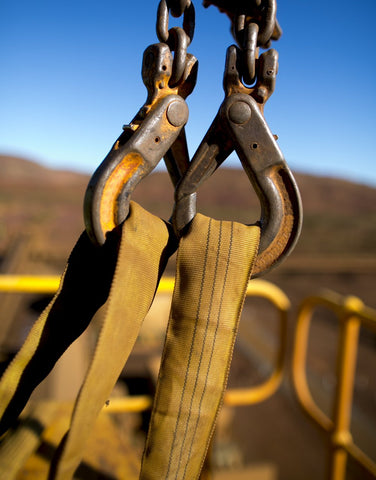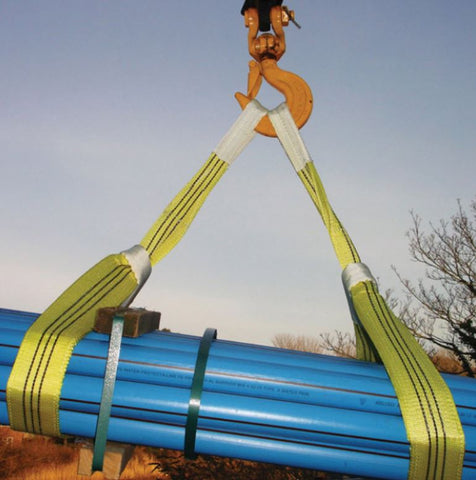Discover everything you need to know about webbing slings in our comprehensive guide
Webbing slings are versatile and essential tools used in a variety of industries for lifting and securing heavy loads. In this comprehensive guide, we will delve into the world of webbing slings, covering everything from their definition and uses to selecting the right sling, proper use, maintenance and inspection, and troubleshooting common issues. Whether you are new to webbing slings or a seasoned professional, this guide will provide you with valuable insights and practical tips to ensure safe and efficient lifting operations.
Understanding Webbing Slings
Definition and Uses of Webbing Slings
Webbing slings, also known as lifting slings, are flexible straps made from high-strength synthetic materials such as polyester. Their primary purpose is to lift and secure heavy loads by providing support and stability. Webbing slings are extensively used in various industries, including construction, manufacturing, logistics, and shipping. They are suitable for a wide range of applications, from lifting machinery and equipment to securing cargo during transportation.
When it comes to lifting heavy loads, safety is of utmost importance. Webbing slings offer a reliable and efficient solution, ensuring that your lifting operations are carried out smoothly and securely.
Different Types of Webbing Slings
There are several types of webbing slings available, each designed for specific lifting requirements. The most common types include:
Flat Web Slings: These slings have a simple, flat construction and are ideal for general lifting purposes. They provide a wide bearing surface, distributing the load evenly and reducing the risk of damage to the load.
Round Slings: Made from a continuous loop of webbing, round slings offer increased flexibility and load-bearing capacity. Their soft and pliable nature allows them to conform to the shape of the load, minimizing any potential damage.
Endless Slings: With no seams or stitching, endless slings provide excellent durability and strength. They are particularly suitable for lifting irregularly shaped loads, as they can be adjusted to fit the contours of the load securely.
Metal Mesh Slings: These slings are crafted from metal mesh for added resistance to heat and sharp edges. They are commonly used in industries where extreme temperatures or sharp objects are present, providing enhanced safety and longevity.
Each type of webbing sling has its own advantages and considerations, so it is crucial to choose the right sling for your specific lifting needs. Taking into account factors such as load weight, shape, and environmental conditions will help you select the most suitable sling for the job.

Key Features of Webbing Slings
Webbing slings are designed with various features to enhance their performance and safety. Some key features to look for when selecting a webbing sling include:
Safe Working Load (SWL) Capacity: This indicates the maximum weight that the sling can safely lift. It is essential to ensure that the SWL capacity of the sling matches or exceeds the weight of the load you intend to lift.
Length and Width: The dimensions of the sling determine its suitability for different lifting applications. Longer slings provide increased versatility, allowing for a wider range of lifting configurations.
Colour Coding: Many slings are color-coded to indicate their load capacity and aid in identifying the correct sling for the task. This visual cue helps prevent errors and ensures that the right sling is used for each lifting operation.
Reinforced Loops: The loops at each end of the sling are typically reinforced to provide extra strength and durability. This reinforcement minimizes the risk of fraying or tearing, enhancing the overall lifespan of the sling.
Understanding these key features will help you make an informed decision when selecting the right webbing sling for your lifting operations. By choosing a sling that matches your specific requirements, you can ensure the safety and efficiency of your lifting tasks.
Remember, proper training and adherence to safety guidelines are crucial when using webbing slings. Regular inspections and maintenance of the slings are also necessary to detect any signs of wear or damage, ensuring their continued reliability and performance.
Selecting the Right Webbing Sling
Factors to Consider When Choosing a Webbing Sling
Choosing the appropriate webbing sling for a lifting task involves considering several crucial factors. Here are some essential considerations:
Weight and Load Size: Determine the weight and size of the load to ensure that the sling has the necessary capacity and dimensions.
Environmental Conditions: Consider the operating environment, including temperature, moisture, and exposure to chemicals or UV radiation, to select a sling that can withstand these conditions.
Application Specifics: Different lifting applications may require specific features or types of slings. Assess the unique needs of your task to make the right choice.
By carefully evaluating these factors, you can ensure that you select a webbing sling that meets your lifting requirements and provides optimal performance and safety.

Understanding Load Capacity
Load capacity is a critical consideration when working with webbing slings. Exceeding the safe working load can lead to sling failure and compromise the safety of the lifting operation.
To determine the appropriate load capacity, you should consider the weight of the load, the angles of the slings, and any additional factors such as shock loading or dynamic forces. Consulting load charts or seeking professional advice can help ensure accurate load capacity calculations.
Material and Durability Considerations
Webbing slings are available in various materials, with polyester being the most common due to its high strength and resistance to chemicals and UV radiation. Other materials, such as nylon or polypropylene, may be suitable for specific applications.
Additionally, consider the durability of the sling, including factors like abrasion resistance, resistance to wear and tear, and the lifespan of the material. Regular inspection and maintenance are crucial to prolonging the life of the sling and ensuring safe operation.
Proper Use of Webbing Slings
Safety Guidelines for Using Webbing Slings
Using webbing slings safely is paramount to prevent accidents and injuries. Follow these essential safety guidelines when working with webbing slings:
- Inspect the sling for any signs of damage, such as cuts, tears, or fraying, before each use.
- Avoid sharp edges or contact with abrasive surfaces that may cause damage to the sling.
- Ensure proper rigging techniques, including appropriate hitch types and angles, to maintain load stability and avoid overloading.
- Use appropriate lifting equipment, such as shackles or hooks, and ensure secure attachments to the load and lifting device.
- Never stand under a suspended load or allow personnel to work beneath the load.
Adhering to these safety guidelines will reduce the risk of accidents and ensure the safe and effective use of webbing slings. With our Web Sling Safety Awareness Course, you will learn this and more to use your slings safely and effectively.
Tips for Maximizing the Lifespan of Your Webbing Sling
To extend the lifespan of your webbing sling and optimize its performance, consider the following tips:
- Store slings in a clean, dry, and well-ventilated environment to prevent moisture and UV damage. Avoid exposing slings to extreme temperatures, chemicals, or direct sunlight, as these can degrade the material.
- Regularly inspect slings for any signs of wear or damage, and promptly replace any slings that do not meet safety standards.
- Clean slings using mild soap and water, and avoid using harsh solvents or abrasive materials that could weaken the fabric.
By following these maintenance tips, you can ensure the longevity and optimal performance of your webbing sling.

Maintenance and Inspection of Webbing Slings
Regular Inspection Checklist
Regular inspection of webbing slings is crucial for identifying any signs of wear, damage, or degradation that could compromise their safety and effectiveness. Use the following checklist during inspections:
- Check for cuts, tears, frays, or broken stitches.
- Inspect the loops for any signs of damage or wear.
- Look for signs of chemical or UV degradation.
- Ensure that labels and markings on the sling are legible and have not faded.
By conducting regular inspections and addressing any issues promptly, you can maintain the safety and functionality of your webbing sling.
Cleaning and Storing Your Webbing Sling
Proper cleaning and storage of webbing slings are essential for preserving their integrity and ensuring their longevity. Follow these guidelines:
- Clean slings using mild soap and water, gently scrubbing any affected areas.
- Avoid using abrasive materials or harsh solvents that could damage the fabric.
- Thoroughly dry the sling before storing it in a clean, dry environment, away from direct sunlight and extreme temperatures.
- Store slings in a dedicated storage area, hanging or coiling them properly to prevent tangling or kinks.
By adhering to these cleaning and storage practices, you can ensure that your webbing slings remain in optimal condition for their intended use.
Troubleshooting Common Issues
Identifying and Addressing Wear and Tear
Over time, webbing slings may exhibit signs of wear and tear that can compromise their strength and safety. Here are common wear and tear issues to watch out for:
- Cuts or Tears: If a sling shows any signs of cuts or tears, it should be immediately taken out of service and replaced.
- Fraying or Abrasion: Excessive fraying or abrasive damage weakens the sling, necessitating a replacement.
- UV or Chemical Degradation: Slings that display signs of UV or chemical degradation should be inspected and replaced if necessary.
Regular inspections and prompt action when wear and tear are detected are essential for maintaining safe lifting operations.
What to Do in Case of Sling Failure
In the unfortunate event of a sling failure, immediate action is crucial to prevent further damage or injuries. Here are the steps to take:
- Safely evacuate the area and notify personnel of the situation.
- Secure the failed sling to prevent any potential hazards.
- Inspect the sling to determine the cause of failure and assess the damage.
- Replace the failed sling with a new one before resuming lifting operations.
Investigating the cause of sling failure can help prevent similar incidents in the future, ensuring a safer work environment.

Conclusion
Lifting slings are indispensable tools for lifting and securing heavy loads in various industries. Understanding their definition, types, key features, and proper use is essential for safe and efficient lifting operations.
By selecting the right webbing sling, adhering to safety guidelines, conducting regular maintenance and inspections, and troubleshooting any issues promptly, you can ensure the longevity, functionality, and safety of your webbing slings.
Remember, safety should always be the top priority when working with webbing slings. By incorporating these best practices into your lifting operations, you can confidently and successfully carry out any lifting task with ease and peace of mind.

